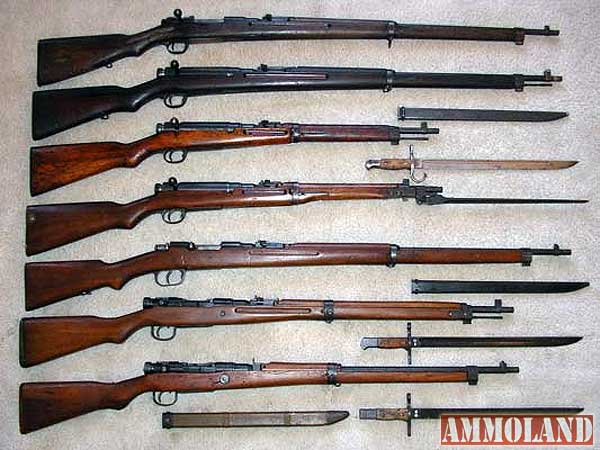Japanese Rifles of World War II
Gun Collecting
By Peter Peter Suciu


Michigan –-(Ammoland.com)- Japanese rifles often get a bad rap, at least when compared to the rifles of the other major combatant powers of World War II.
Even collectors of militaria view the Japanese rifles as being of a lower quality, but this isn’t quite true.
One reason for this misconception is that much of what survived, and is now in collections is actually from the later war years, thus not up to the highest quality.
“The fit, finish & overall quality of manufacture on early Japanese weapons equals if not surpasses weapons made by other participants of World War II,” explains advanced Japanese militaria collector Jareth Holub. “It wasn’t until the very last two years, due to U.S. air strikes, that factories started producing subpar products.”
The result is that many of the small arms encountered – notably the famous rifles – are actually late war items. This has resulted in the misconception that Japanese small arms were always somewhat inferior. It is true however that the two main combat rifles, the Arisaka Type 38 and the Type 99 rifles were essentially based on technology used a generation earlier – but it should be remembered that the same held true for most of the other powers at the start of World War II as well. Even the United States was still in the process of rearming with the M1 rifle, and thus large numbers of 1903 Springfield rifles were used in the early stages of the war.
Likewise, Germany and Russian were using their respective bolt action rifles at war’s end, as were the British. The Japanese actually faced greater resource problems than the other powers, but they also had cultural issues – essentially a “want not, need not” mentality. Additionally, another issue complicated matters for the Japanese military, namely the acknowledged rivalry and simmering hatred between the Japanese army and navy.
“This led to the navy having to struggle to procure arms and equipment from the government & eventually led up to the navy establishing its own arsenal systems,” emphasizes Holub. “This backbiting and infighting hindered the cooperation between the branches of service and greatly affected the outcome of the war. The Japanese were a very frugal people who didn’t believe in wasting anything including bullets. This was one of the reasons why their submachine gun production was limited. Had they increased production and distribution it might have changed their combat tactics.”
The two main rifles used by the Japanese in World War II are both often called the “Arisaka.” These were named after Colonel Nariake Ariska, who was responsible for creating the commission to find a new rifle. The first pattern was known as the Type 30 rifle (the 30 comes from the 1897 A.D., which was the 30th year of the Emperor Meiji), and this was updated following the Russo-Japanese War in 1905. The new model thus became the Type 38, and it saw service during the First World War – and would remain in service well into World War II and beyond. It was chambered in the 6.5x50SR and more than three million of these were made. The gun clearly was influenced by the German K98 and other Mauser designs. A number of variants existed, including a Type 44 Cavalry Rifle and a Type 97 Sniper Rifle.
During the Second Sino-Japanese War, which began in 1931, it was apparent that a larger cartridge was needed and the Japanese adopted the 7.7x58mm round, based on the British .303 (7.7x57R). To confuse collectors and military historians for decades, this rifle was designated the Type 99 – which in this case refers to the Japanese year 2099, which was believed to be the date of the creation of the world.
It was originally the intention of the Imperial Japanese Army to replace the aging Type 38 with the Type 99, but this was not possible, and with limited resources the two firearms were used side-by-side. Thus the moniker of “Arisaka” is used for both rifles. Because many of the later war rifles were of lower quality, and often called “last ditch” there is a common misconception that all Type 99s were last ditch, but this is far from the case.
Some three and a half million of the Type 99 rifles were made, not counting variations, including the regular short rifle as well as Type 99 Long Rifle, and the Sniper Rifle Type 99. Another version of the rifle, the Type 44 Carbine, was designed primarily for use as a cavalry rifle – although this shouldn’t be confused with the Type 38 Cavalry rifle, a slightly shorter version of the Type 38. The most interesting version is by far the Type 2 Paratroop Rifle, which could broken down into two parts. A final variation are those Type 99 Short Rifles (some 133,000) that were rechambered by the Republic of Korea Army to fire the American .03-06 Springfield cartridge.
Today, the more valuable Type 99s are those with the imperial chrysanthemum intact. Often these were defaced, reportedly by surrendering Japanese soldiers to “preserve the Emperor’s honor,” while another story is that it was a V for Victory and was done by the US Military. Either way, an intact stamp is the more desirable version.
Peter Suciu is executive editor of FirearmsTruth.com, a website that tracks and monitors media bias against guns and our Second Amendment rights. Visit: FirearmsTruth.com
